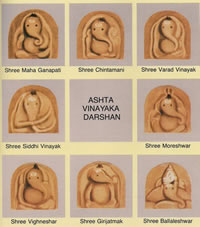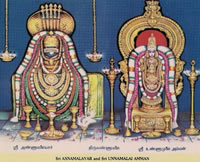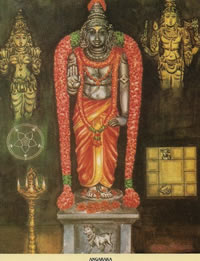INTRODUCTION
Our Heritage contains the pictures of the Murthis from some of the important temples in India along with a brief description. It is being published to help the devotee to understand our religion and arouse in him the thirst for knowing more and more of our culture.
ABOUT OUR DHARMA AND TEMPLE WORSHIP
The Vedas, Dharma Sastras and cosmic moral order are the fountain sources and roots of Dharma.
The Universe rests on Dharma, a way of life ordained on humans.
Our Heritage and Culture is based on the people leading a Dharmic life, based on everlasting moral values designed to ensure cosmic harmony. This is known as Dharma-a unique word, not known to any other religion or cult prevailing in any part of the globe.
Another important factor almost universally accepted, is faith in a Divine Power shaping the destiny of mankind. This is manifested in centres which are the bastions of Divine power (Temples) and sanctified places (Kshetras) of worship, which are preserved by following the rules of agamas(Ceremonial law) relating to Temples, in maintaining Temple worship and by devotees observing the ordained disciplines while resorting to worship.
Temples are of four kinds
1. Swayam Vyaktham- are Kshetras where the Divine Power, of its own accord, manifested itself to serve as centres where people can worship the Divine.
2. Arisham- are centres where Rishis did intense tapasyas and involved the Divine to be present there for all time to come, to enable people to worship.
3. Daivatham- are places where Devas did penance on earth, to expiate for their sins and in response to which the divine power manifested itself to remain for all time to come, to enable people to worship.
4. Manusham- are those founded by people. |

SHANMATHA
GANAPATYAM
SAIVAM
SAKTAM
VAISHANAVAM
KAUMARAM
SAURAM
|
In the first three instances the Temple is the place where Divine power manifest itself. Later, kings, noble men and the devout made the constructions and massive structures like Gopurams according to Agams, and Silpa Sastra (the rules governing temple worship and iconography of Temples).
In the fourth category once the deity is installed after performance of the rituals mentioned in the Agamas, Divine Power(God) descends. Here also the construction of temples is according to Agamas and Silpa Sastra (Iconography of Temples)
Construction of temples are part of the Poortha acts, mentioned in the Dharma Sastras, which are believed to assist the journey of the soul after death. Temple, in the popular parlance, includes the construction also.
SHANMATHA
The Vedas proclaim that all beings are made up of five elements-Earth (Prithvi), Water(Apaha), Fire(Tejas), Air (Vayu) Ether(Aakaasa). These elements are part of the Supreme. Rishis, by their intense tapasya visualized the existence of one Supreme being and the 5 elements which we call nature. These rishis known as Mantra Dhrashtas(Seers of the mantras) were able to grasp the sound vibrations already existing and gave it to posterity as Vedas. They were not inventors or creators of the Vedas. Just as the law of gravity was there even before Newton found it, these mantras or sound vibrations were already existing long before the Rishis grasped them.
 |
Adi Sankara whose Advaita philosophy has found universal acceptance preached that there is only one Supreme being and we are all part of the same. But to reach this goal, one has to pass through various stages. He therefore compsed Slokas(poems) on various deities worshipped by Hindus. He established the Shanmatha, the six aspects or the six deities appealing and conductive to the well being of humanity. |
Ganapatyam
Ganapathi the Lord who removes all obstacles in one's path. Temples have been constructed for Lord Ganapathi throughout the country. In many places it has no roof and is found to have been installed just under a tree on the banks of a river or a holy tank, accessible to His devotees. |
 |
Saivam deals with the worship of Lord Siva while his consort is worshipped as Sakti.i.e. Saktam.
Without Sakti there is no Siva. Siva means Shanti or Peace.
|
 |
Vaishnavam
Vaishnavam is the cult of worshipping Lord Vishnu who, along with his consort Lakshmi, the giver of wealth and fortune, protects and preserves the world. |
 |
Kaumaram
Lord Subramanya or Kumaran is worshipped as an embodiment of Sakti and Siva-protecting all beings in the universe. There are six Kshetras of importance for those worshipping Lord Subrahmanya. |
 |
Sauram
Sauram is the cult where Sun or Surya is worshipped. Surya is an embodiment of power, causing rain, protecting health of all and help the growth of vegetation etc.
|
 |
Since the human body is made of Pancha boothas, the Hindus worship these five elements in the form of Lord Siva at different places known as Panchalinga Kshetras.
Since life is more important for enabling the other elements to be perfect, they worshipped Siva as Jyotir Linga and among temples dedicated to Lord Siva, we have twelve important Kshetras known as Jyotirlinga Kshetras.
Vishnu as the protector undertook various avataras and there are a number of temples dedicated to Him representing his various avatars.
The Hindus believe that every village or town should have its own temple. His Holiness Sri Chandrashekarendra Saraswati Mahaswamiji pointed out that in each street, at one end, there will be a temple for Lord Siva with temples for other deities like Ganapati, Kumaran, Sakti, Navagrahas etc., there will be another temple at the other end for Vishnu.
There are ancient sayings that one should not live in a place where there is no temple and Temple worship is very good for one's well being. |






